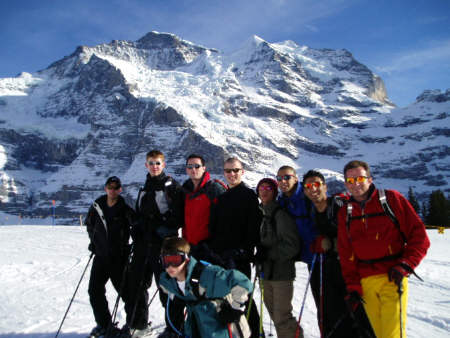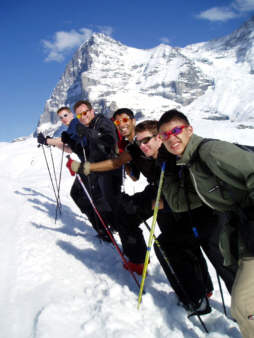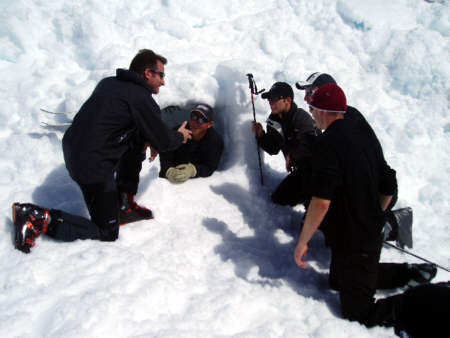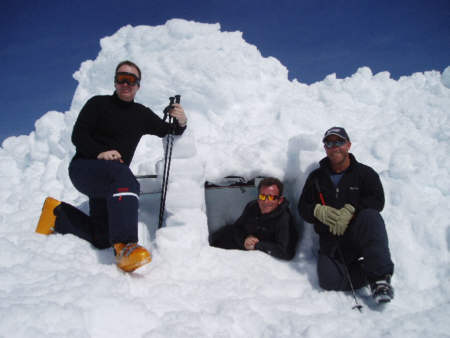Alpine Expedition ‘Snow Eagle 2005’, Switzerland, March 2005
27F Chingford Squadron Air Training Corps
After months of planning and pre-expedition training in the Brecon Beacons and Snowdonia, the team of 12 cadets and 6 RAFVR(T) instructors met at Heathrow airport for the flight to Zurich and short train ride to Wengen for the start of a week long expedition that would meet the aims set during the expedition’s conception. Much of the cadet’s mountainous adventure training in the UK takes place below the snow line and at low altitudes. Therefore, building on previous London Wing expeditions to Mont Blanc New Zealand and the Swiss Alps, it was decided to plan an expedition to offer practical training in Ski-Mountaineering and winter survival skills in a physically demanding and challenging environment.
The first morning was spent meeting our guides, checking equipment, being introduced to the equipment and the basic techniques needed to move on snow with skis. Later the team embarked on a low-level trek along the local cross-country ski routes around the town to break in new boots and travel weary legs. Some of the team members soon discovered that cross-country skiing was considerably more physically demanding than first appeared. After some comical interpretations of technique and with the weather closing in, we returned to the hostel for a much needed meal and brief for the following days activities.
|
|
|
|
|
|
|
The next day the team took the Jungfrau train to the ski fields of Eigergletscher, located below the imposing Eiger North Face, which provided a spectacular backdrop to our training. The team’s technique and competence was developed on progressively steeper slopes until all participants had mastered the basic principles of turning, speed control and stopping. The days strenuous activities were temporarily interrupted when we were involved in providing first aid assistance to a fallen skier who had taken a tumble, sustaining a suspected dislocated shoulder. After stabilising the patient and making him more comfortable, two of our team put their newly acquired skills to the test skiing down to the nearest rescue post to call for help. After assisting the emergency ski patrol in evacuating the casualty, we continued our training, ending the day with a two hour descent back to Wengen.
The following day brought clear skies and spectacular views across the entire Bernese Oberland mountain ranges, a perfect start for our journey on the Jungfrau Railway through the heart of the Eiger to the Jungfraujoch, Europe’s highest railway station at 3454m. A fascinating tunnel network of rock and ice leads out to the glaring sunlight reflected off the Jungfraufirn Glacier, situated between Switzerland’s highest mountain the Jungfrau and the Mönk (the 4107m peak successfully climbed in a previous London Wing expedition). It was here that we were able to start the more technical training and progressive altitude acclimatisation needed for the latter stages of the expedition. Basic rope and glacier traverse skills were revised along with the technique required for crevasse rescues.
Our luck with the weather continued into the next day and the team were introduced to avalanche awareness, basic winter survival skills and the techniques required to build snow holes. The afternoon was spent putting this knowledge into practice with the team split into three groups and tasked with building snow shelters. By the time we had finished we had acquired a substantial audience of puzzled skiers wondering what all the effort and fuss was about as we toiled cutting snow blocks with the edges of our skis. The blocks were then assembled to form the sides of the shelter and the skies provided the support for the roof structure. The interiors were then dug out to form an area just big enough to sleep in for each of the teams. Ironically, with the sun beating down, the snow shelters provided more protection from heat of the sun than their intended function of keeping the occupants warm and sheltered from the cold!
As the sun rose over the Trugberg ridge the next morning, we set off for the descent of the Jungfraufirn Glacier. The snow toped expanse of the glacier was framed by steep rock on either side, providing a dramatic setting for our gentle decent. With some members of the team still nursing aching muscles and bruises from the previous day’s physical exploits, the heavy snow proved hard going. But as our skill developed we were able to make good progress, reaching the junction of the Emigschneefäld Glacier by late morning. Now the hard work began. Although the winter snow covering provided a route through the fragmented crevasse of the glacier junction, we had to choose our route carefully to negotiate a safe passage. We then began the long accent of towards the Walcherhorn, a climb of 750 meters. With our lungs screaming for air and our legs protesting, we climbed over the Obers Mönchsjoch back into the Jungfraufirn Glacier and the final decent to Jungfraujoch Station. We had covered approximately 20km of terrain in some of the most spectacular scenery the Alps had to offer, but not without some serious physical exertion. The train journey back to the Eigergletscher provided a welcome opportunity for some rest and sleep before the final ski decent back to Wengen and our final nights stay in our winter playground.
All the participants enjoyed the expedition, its objectives were met and a number of cadets have used their participation towards gaining their Gold Duke of Edinburgh’s Award. Our thanks to HQ Air Cadets, HQ London Wing, the Reserve Forces & Cadets Association for Greater London and the Ulysses Trust for their support and fanatical assistance. Without such assistance the expedition would not have been the success it was.
Flt Lt R Gillett RAFVR(T), OC 27F Sqn ATC



